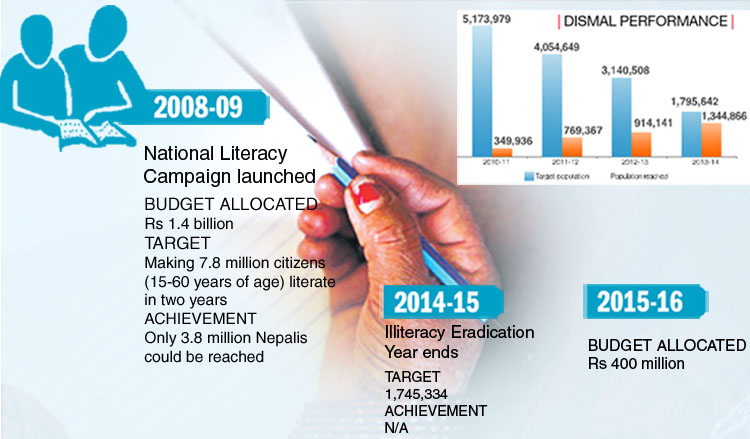Literacy campaign a damp squib
The ambitious National Literacy Campaign, launched seven years ago with an aim to make all Nepalis literate, has ended without accomplishing its mission, highlighting the lackadaisical approach that has been taken by the successive governments in the past.
Stating that illiteracy is both a cause and consequence of poverty, deprivation and under-development, then finance minister Baburam Bhattarai had announced the NLC in the fiscal year 2008-09 with the slogan ‘Know Letters, Be Civilised’. When launched, the mission aimed at eradicating illiteracy within two years and the government had allocated Rs 1.4 billion for the purpose. But even after seven years, the target is still far.
The number of illiterate persons between 15 and 60 years of age in the country in 2008 was around 7.8 million. In the first two years, only 3.8 million Nepalis between 15 and 60 years of age could be made literate. The campaign hence was given continuity.
A household survey conducted by Non Formal Education Centre in 2010 found that a total of 5,173,979 Nepalis (3,435,336 women and 1,738,643 men) were still illiterate. The literacy programme conducted in 2010 and 2011 could make 349,963 and 769,367 Nepalis literate, respectively.
Similarly, the target of NFEC in 2012 and 2013 was to make 1,105,063 and 1,693,165 citizens literate, respectively, but it could make only 914,141 and 1,344,866 citizens literate, respectively, in these two years.
To give an impetus to the campaign, fiscal year 2014-15 was declared ‘Illiteracy Eradication Year’, with an aim to reach out to all the illiterate population in the country by the end of the fiscal. Sadly, fiscal year 2014-15 has ended without achieving the target.
The government had plans to make 1,745,334 illiterate people across the country literate in the fiscal year 2014-15. The government even launched ‘focused programme’ in 17 districts of Tarai — Jhapa, Morang, Siraha, Saptari, Sarlahi, Mahottari, Dhanusha, Bara, Parsa, Rautahat, Nuwakot, Rupandehi, Kapilvastu, Nawalparasi, Dang, Banke and Kailali — with an aim to reach out to 1,497,372 illiterate population, but failed. Till date only three districts — Dang, Rupandehi and Nawalparasi — have been declared fully literate.
Keshav Dahal, Deputy Director, NFEC, on Thursday said out of 75 districts, only 20 districts have been declared fully literate districts, which means the mission to declare country a fully literate country by the end of 2014-15 could not be accomplished. Seven districts were declared fully literate in 2013-14 while 10 districts were declared fully literate in 2015-16. NFEC plans to declare three more districts fully literate by mid-August. On how many people were made literate in 2015-16, Dahal said, “We are collecting and compiling data, which will be published by the end of July.”
In 2015-16, which was to be celebrated as ‘Illiteracy Eradication Year’, the government had allocated Rs 1 billion. Since the campaign now has come to an end, Dahal said, the government has deducted the budget for fiscal year 2015-16.
The government has allocated only Rs 400 million for NFEC for 2015-16 to conduct regular literacy classes for the people who could not be reached in 2014-15.






